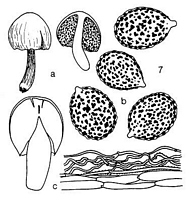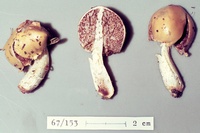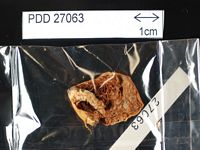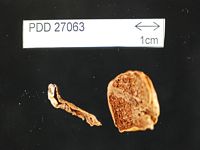|
 Cortinarius luteobrunneus Cortinarius luteobrunneus
SynonymsThaxterogaster leoninus
BiostatusPresent in region - Indigenous. Endemic
Images (click to enlarge)
Caption: Thaxterogaster leoninum Hk. sp.n. (type): a. fruitingbodies.
b. spores c. cuticle. | 
Caption: ZT67-153 , Holotype
Owner: E. Horak: © Creative Commons Attribution-Noncommercial 3.0 New Zealand | 
Caption: Dried type specimen
Owner: Herb PDD | 
Caption: Dried type specimen
Owner: Herb PDD | |
Article: Horak, E. (1973). Fungi Agaricini Novazelandiae I-V. Beihefte zur Nova Hedwigia 43: 200 p.
Description: Gastrocarp
25-35 x 25-40 mm, hemispherical or ovoid, peridium (1-2 mm thick) yellow or
yellow-brown, glutinous, smooth, margin dehiscent from stipe, without conspicuous
veil remnants. Gleba loculate, chambers up to 2 mm diam., indistinctly radially
arranged, in aged carpophores dehiscent from stipe and then exposed but always
covered with white, 1 mm thick 'cortina’, loculi not shining through, deep rust
brown. Stipe 30-55 x 5-14 mm, cylindric or clavate, attenuated above and columella
sometimes rudimentary or even lacking, white, silky, dry, occasionally covered
with glutinous patches from the margin of the peridium. Context white. Odor
and taste not distinctive. Chemical reactions on peridium: KOH, NH3
and HCl - negative.
Spores
15-18 x 10.5-12.5 µm, ovoid or broadly ovate, mostly axially symmetric, coarsely
verrucose, perisporium well developed, ferruginous. Basidia 36-50 x 10-13 µm,
4-spored. Cystidia absent. Epicutis: a cutis consisting of strongly gelatinised
hyaline hyphae with yellow pigment encrusting the thin-walled membranes. Clamp
connections present.
Habitat: On
ground amongst litter of Nothofagus cliffortioides, in montane forests.
New Zealand.
Notes: This
species was observed several times in the montane Nothofagus cliffortioides-
forests around the type locality. It appears that this species prefers to fructificate
during late winter and early spring; therefore, no further records were obtained
in other regions of New Zealand as at this time of the year no mycological fieldwork
was undertaken.
|